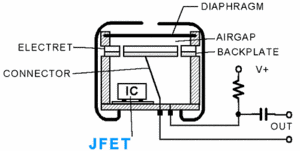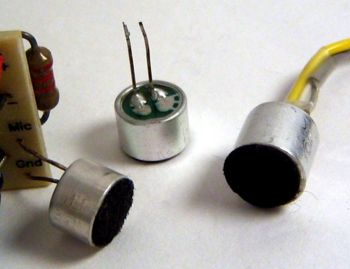The device operates on the principle that the microphone will convert the sound into an analog input to the PIC and, as the sound increases in volume, the analog input’s amplitude will increase.
This input is then converted into an output on the set of LEDs soldered onto the PIC’s circuit board. This output works as a light bar; it displays the minimum one LED for quiet sound levels and activates additional LEDs as the sound becomes louder – up to a maximum of eight. The sensitivity of the microphone is adjustable through a gain potentiometer.
The most commonly used microphones for audio use capacitance charge (condenser microphones), electromagnetic generation (dynamic microphones), or piezoelectric generation. In a [condenser microphone], a thin membrane of the microphone acts as one plate of a capacitor and a nearly constant charge is maintained on the capacitor.
The voltage maintained across the capacitor plates changes with the vibrations in the air, according to the capacitance equation:
[Q = C \cdot V] where Q = charge in coulombs, C = capacitance in farads and V = potential difference in volts, resulting in a change in output voltage.
Power is necessary for establishing the capacitor plate voltage, and is also needed for internal amplification of the signal to a useful output level. Electret microphones, a type of condenser microphone, replace the externally-applied charge with a permanently fixed-charged material.
The electret is a stable dielectric material with a permanently-embedded static charge. Electret microphones require no polarizing voltage but, due to their integrated pre-amplifier, require a small amount of power either from microphone inputs as phantom power or from a small battery. Due to mass-production of these devices, electret microphones lack the precision needed for high-quality microphones.
Due to the variable nature of ambient noise, a calibration “reset” button was included that would reset the output LEDs based on the environment’s baseline noise level. This calibration was done via software averaging of the ambient volume level.
The device that is built currently follows the principles of the clapper device in that the higher the analog input is received, the more LEDs will be shown. However, due to the brevity of the audio input peak for shorter signals such as a clap, it is sometimes difficult to see the correspondingly brief output.
A further step would be to install a software switch that would detect the characteristic sound pattern of a clap and activate a digital output upon recognition.

